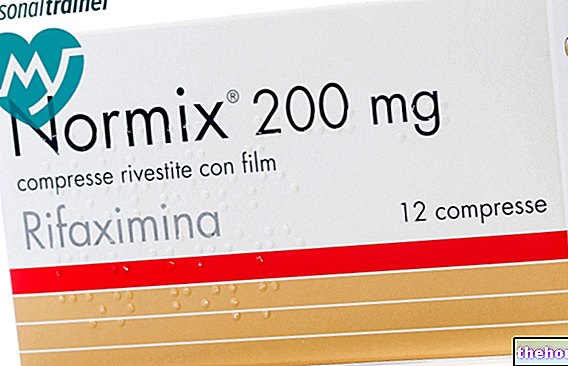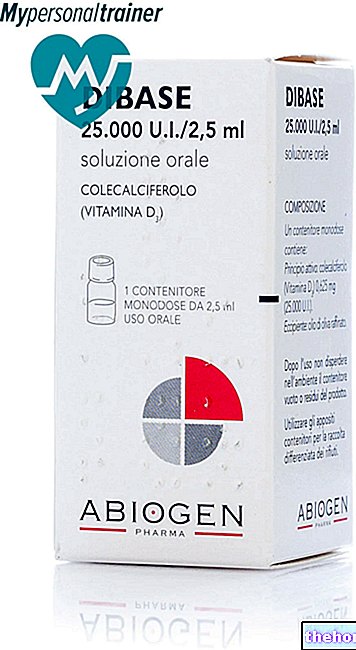Active ingredients: Dextromethorphan (Dextromethorphan hydrobromide), Guaifenesina
SEDATIVE AND FLUIDIFYING BRONCHENOL, 1,5 mg / ml + 10 mg / ml, syrup
The leaflets of Bronchenolo sedative and fluidifying are available for the packs:- SEDATIVE AND FLUIDIFYING BRONCHENOL, 1,5 mg / ml + 10 mg / ml, syrup
- SEDATIVE AND FLUIDIFYING BRONCHENOL, 7.5 mg + 55 mg, mint flavored tablets
Why is Bronchenolo used as a sedative and fluidifying agent? What is it for?
This medicine contains 2 active ingredients:
- dextromethorphan hydrobromide, which is used to calm coughs;
- guaifenesin, which works by thinning the phlegm. which belong to the class of cough suppressants and expectorants
SEDATIVE AND FLUIDIFYING BRONCHENOL is used for the symptomatic treatment of cough, it is used to calm the cough and to make the phlegm more fluid, therefore more easily eliminated.
Talk to your doctor if you do not feel better or if you feel worse after 5-7 days of treatment.
Contraindications When should not be used Bronchenolo sedative and fluidifying
Do not take SEDATIVE AND FLUIDIFYING BRONCHENOL if:
- you are allergic to dextromethorphan hydrobromide, guaifenesin or any of the other ingredients of this medicine (listed in section 6);
- you are taking or have taken within the last two weeks medicines used for depression called monoamine oxidase inhibitors (MAOIs);
- have or are likely to have breathing problems (respiratory failure), for example you have chronic obstructive airway disease, pneumonia, an ongoing asthma attack or worsening of asthma.
Do not use SEDATIVE AND FLUIDIFYING BRONCHENOL in children under 6 years of age.
Precautions for use What you need to know before taking Bronchenolo sedative and fluidifying
Talk to your doctor or pharmacist before taking BRONCHENOL SEDATIVE AND FLUIDIFYING if:
- have a long-term cough (chronic or persistent), such as that occurs in asthma or emphysema;
- have severe liver or kidney problems;
- are taking medicines used for depression called selective serotonin reuptake inhibitors or tricyclic antidepressants;
- are taking other cough or cold medicines.
If your cough does not improve or if you notice a high fever, skin lesions such as patchy or diffuse color changes (rash) or persistent headache, contact your doctor as your therapy may need to be adjusted.
Take care as this medicine can cause changes (false positives) in tests that measure the concentration of vanylmandelic acid in the urine. In this case, tell your doctor that you are taking SEDATIVE AND FLUIDIFYING BRONCHENOL.
Interactions Which drugs or foods can modify the sedative and fluidifying effect of Bronchenolo
Do not take this medicine if you are taking or have taken in the last two weeks medicines used for depression, called monoamine oxidase inhibitors (MAOIs), as this increases the risk of even serious adverse reactions, such as serotonin syndrome (see section 4).
Tell your doctor or pharmacist if you are taking, have recently taken or might take any other medicines. This is especially important if you are being treated with:
- medicines used for depression called selective serotonin reuptake inhibitors or tricyclic antidepressants;
- phenylpropanolamine, a medicine used for colds;
- medicines that inhibit cytochrome P450 2D6, such as:
- quinidine and amiodarone, used against changes in the rhythm of the heart (arrhythmias);
- fluoxetine and paroxetine, used against depression;
- haloperidol and thioridazine, used in diseases that cause loss of contact with reality (psychosis).
SEDATIVE AND FLUIDIFYING BRONCHENOL with alcohol
Do not drink alcohol while taking this medicine, as this may cause or worsen some side effects, for example sleepiness.
Warnings It is important to know that:
Pregnancy and breastfeeding
If you are pregnant or breast-feeding, think you may be pregnant or are planning to have a baby, ask your doctor or pharmacist for advice before using this medicine.
In pregnant and lactating women, the medicine should be administered only in case of real need and under the direct supervision of the doctor.
Driving and using machines
SEDATIVE AND FLUIDIFYING BRONCHENOL can cause drowsiness and dizziness. Take special care before driving or using machines.
SEDATIVE AND FLUIDIFYING BRONCHENOL contains:
- sucrose; if you have been told by your doctor that you have an intolerance to some sugars, contact your doctor before taking this medicinal product;
- propyl and methyl para-hydroxybenzoates, which can cause allergic reactions (including delayed);
- ethyl alcohol. This medicinal product contains 5.94% ethanol (alcohol), i.e. up to 470 mg per dose, equivalent to 11.9 ml of beer and 4.9 ml of wine. It can be harmful to alcoholics. To be taken into consideration in pregnant or lactating women, children and high-risk groups such as people with liver disease or epilepsy.
For those who carry out sporting activities, the use of medicines containing ethyl alcohol can determine positive doping tests in relation to the alcohol concentration limits indicated by some sports federations.
Dose, Method and Time of Administration How to use Bronchenolo sedative and fluidifying: Dosage
Always take this medicine exactly as described in this leaflet or as directed by your doctor or pharmacist. If in doubt, consult your doctor or pharmacist.
Adults and children over 12 years old: 2 teaspoons (10 ml), 2-4 times a day, up to a maximum of 8 teaspoons (40 ml) per day;
Children between 6 and 12 years of age: 1 teaspoon (5 ml), 3-4 times a day, up to a maximum of 4 teaspoons (20 ml) per day.
Wait at least 4-6 hours between one dose and the next. Do not exceed the indicated doses without your doctor's advice.
Method of administration
Take BRONCHENOL SEDATIVE AND FLUIDIFYING syrup by mouth (orally).
Open the bottle by pressing and turning the cap at the same time. After taking the dose, close the bottle by pressing down and screwing the cap on.
If you forget to take SEDATIVE AND FLUIDIFYING BRONCHENOL
Do not take a double dose to make up for a forgotten dose.
Overdose What to do if you have taken an overdose of sedative and thinning Bronchenol
Contact your doctor immediately or go to the nearest hospital emergency department as appropriate measures may be needed.
In the event of an overdose, the risk of having side effects increases. You may also notice: excitement, confusion, agitation, nervousness and instability of character (irritability), stupor, loss of muscle coordination (ataxia), altered muscle tone (dystonia), hallucinations, loss of contact with reality (psychosis) ) and breathing problems (respiratory depression).
Undesirable Effects What are the side effects of a sedative and fluidifying Bronchenolo
Like all medicines, this medicine can cause side effects, although not everybody gets them.
Tell your doctor if during treatment with BRONCHENOL SEDATIVE AND FLUIDIFYING you notice:
Uncommon side effects (may affect up to 1 in 100 people)
- sleepiness and dizziness;
- discomfort in the abdomen, stomach or intestines, nausea, vomiting;
Not known side effects (frequency cannot be estimated from the available data)
- allergic reactions that occur with more or less sudden onset of skin lesions such as, for example, spot or diffuse color changes (rash), hives, swelling (angioedema) of the face, eyes, lips, throat with breathing difficulties;
- serotonin syndrome manifested by changes in mental status, increased blood pressure, agitation, short and involuntary muscle contractions, increased reflexes, excessive sweating, chills and tremors. This side effect is more likely if you use this medicine in combination with your depression medicines.
Reporting of side effects
If you get any side effects, talk to your doctor or pharmacist. This includes any possible side effects not listed in this leaflet. You can also report side effects directly via the national reporting system at “www.agenziafarmaco.it/it/responsabili.” By reporting side effects you can help provide more information on the safety of this medicine.
Expiry and Retention
Keep this medicine out of the sight and reach of children.
No special storage precautions are required.
Do not use this medicine after the expiry date which is stated on the package after EXP. The expiry date refers to the last day of that month.
Do not throw any medicines via wastewater or household waste. Ask your pharmacist how to throw away medicines you no longer use. This will help protect the environment.
Other information
What BRONCHENOL SEDATIVE AND FLUIDIFYING contains
The active ingredients are: dextromethorphan hydrobromide and guaifenesin.
100 ml of syrup contain: 0.15 g dextromethorphan hydrobromide and 1.00 g guaifenesin.
The other ingredients are: mountain pine essential oil; citric acid monohydrate; alcohol; glycerol; sucrose; sweet orange essence; propyl parahydroxybenzoate; methyl para-hydroxybenzoate; sodium saccharin; purified water.
Description of the appearance of BRONCHENOL SEDATIVE AND FLUIDIFYING and contents of the package
SEDATIVE AND FLUIDIFYING BRONCHENOL is available in a 150 ml bottle with a child resistant closure, containing orange-flavored syrup.
Source Package Leaflet: AIFA (Italian Medicines Agency). Content published in January 2016. The information present may not be up-to-date.
To have access to the most up-to-date version, it is advisable to access the AIFA (Italian Medicines Agency) website. Disclaimer and useful information.
01.0 NAME OF THE MEDICINAL PRODUCT
SEDATIVE AND FLUIDIFYING BRONCHENOL
02.0 QUALITATIVE AND QUANTITATIVE COMPOSITION
100 ml of syrup contain:
§ active principles: dextromethorphan hydrobromide 0.15 g and guaifenesin 1.00 g;
Excipients with known effects: sucrose, propyl and methyl para-hydroxybenzoates, ethyl alcohol.
One tablet contains:
§ active principles: dextromethorphan hydrobromide 7.5 mg and guaifenesin 55 mg;
Excipients with known effects: sucrose, aspartame.
For the full list of excipients, see section 6.1.
03.0 PHARMACEUTICAL FORM
Syrup
Pads
04.0 CLINICAL INFORMATION
04.1 Therapeutic indications
Symptomatic treatment of cough.
04.2 Posology and method of administration
Dosage
Syrup
Adults (including the elderly): 2 teaspoons (10ml) 2-4 times per day, up to a maximum of 8 teaspoons (40ml) per day.
Pediatric population
Children over 12 years: 2 teaspoons (10ml) 2-4 times a day, up to a maximum of 8 teaspoons (40ml) per day.
Children from 6 to 12 years: 1 teaspoon (5 ml) 3-4 times a day, up to a maximum of 4 teaspoons (20 ml) per day.
Administer the medicine every 4-6 hours as needed.
Pads
Adults (including the elderly): 3-6 tablets per day to be dissolved in the mouth, up to a maximum of 6 tablets per day.
Pediatric population
Children over 12 years: 3-6 tablets per day to be dissolved in the mouth, up to a maximum of 6 tablets per day.
Children from 6 to 12 years: 2-3 tablets per day to be dissolved in the mouth, up to a maximum of 3 tablets per day.
Administer the medicine every 4-6 hours as needed.
Method of administration
To be administered orally only.
Do not exceed the recommended dose.
04.3 Contraindications
Hypersensitivity to the active substances or to any of the excipients listed in section 6.1.
Children under the age of 6.
Patients who are taking or have taken monoamine oxidase inhibitor antidepressants (MAOIs) within the last two weeks (see section 4.5).
Patients with respiratory failure or at risk of developing respiratory failure (eg patients with chronic obstructive airway disease or pneumonia, patients with ongoing asthma attack or exacerbation of asthma).
04.4 Special warnings and appropriate precautions for use
In the following cases BRONCHENOL SEDATIVE AND FLUIDIFYING must be used only after careful medical evaluation:
• chronic or persistent cough, such as that which occurs in the case of asthma or emphysema;
• severe hepatic insufficiency;
• severe renal insufficiency;
• concomitant use of selective serotonin re-uptake inhibitor antidepressants or tricyclic antidepressants (see section 4.5).
The patient should be advised to consult the physician if the cough persists, or if it is accompanied by a high fever, skin rash or persistent headache.
Do not exceed the maximum recommended dose or frequency of administration. After 5-7 days of treatment with no appreciable results, a clinical evaluation is required.
Simultaneous use of other cough and cold medicines should be avoided.
The concomitant use of alcohol should be avoided during therapy with SEDATIVE AND FLUIDIFYING BRONCHENOL.
Information on excipients with known effects
BRONCHENOL SEDATIVE AND FLUIDIFYING syrup contains:
§ sucrose. Patients with rare hereditary problems of fructose intolerance, glucose-galactose malabsorption, or sucrase isomaltase insufficiency should not take this medicine;
§ ethyl alcohol. This medicinal product contains 5.94% ethanol, i.e. up to 470 mg per dose, equivalent to 11.9 ml of beer and 4.9 ml of wine. It can be harmful to alcoholics. To be taken into consideration in pregnant or lactating women, children and high-risk groups such as people with liver disease or epilepsy;
§ propyl and methyl para-hydroxybenzoates, which can cause allergic reactions (even delayed).
SEDATIVE AND FLUIDIFYING BRONCHENOL mint flavor tablets contain:
§ sucrose. Patients with rare hereditary problems of fructose intolerance, glucose-galactose malabsorption, or sucrase isomaltase insufficiency should not take this medicine;
§ aspartame. This medicine contains a source of phenylalanine. It can be harmful to you if you have phenylketonuria.
04.5 Interactions with other medicinal products and other forms of interaction
The medicinal product should not be used concurrently with or within 2 weeks of treatment with monoamine oxidase inhibitor antidepressants (MAOIs), as serious adverse reactions, including serotonin syndrome, have been reported (see section 4.3).
Patients should be advised to consult their physician before taking dextromethorphan in combination with the following drugs:
• concomitant use of dextromethorphan with selective serotonin re-uptake inhibitor antidepressants or tricyclic antidepressants may cause serotonin syndrome with changes in mental status, hypertension, agitation, myoclonus, hyperreflexia, diaphoresis, chills and tremors (see section 4.4);
• Serum levels of dextromethorphan may be increased by concomitant use of cytochrome P450 2D6 inhibitors, such as the antiarrhythmics quinidine and amiodarone, antidepressants such as fluoxetine and paroxetine, or other drugs that inhibit cytochrome P450 2D6 such as haloperidol and thioridazine;
• the concomitant use of dextromethorphan and alcohol can increase the depressant effects on the central nervous system of both substances.
The association with phenylpropanolamine should be used with caution in subjects with hypertension, heart disease, diabetes, peripheral vasculopathy, prostatic hypertrophy and glaucoma.
Treatment with guaifenesin can cause false positives in the urinary vanylmandelic acid dosage.
04.6 Pregnancy and breastfeeding
No data on pregnancy and lactation are available.
In pregnant and lactating women, the medicine should be administered only in case of real need and under the direct supervision of the doctor.
04.7 Effects on ability to drive and use machines
Since the medicine can make you drowsy or dizzy, this must be taken into account by those who may drive vehicles or attend operations requiring integrity of the degree of vigilance.
04.8 Undesirable effects
Data from clinical studies
The adverse events reported below were observed in clinical studies and are considered uncommon adverse reactions (i.e. occurring in a percentage ranging from ≥1 / 1000 to
Nervous system disorders
§ sleepiness.
Ear and labyrinth disorders
§ vertigo.
Gastrointestinal disorders
§ gastrointestinal disorder;
§ nausea;
§ He retched;
§ abdominal discomfort.
Post marketing data
Adverse reactions identified during post-marketing use are listed below. As these reactions are reported voluntarily from a population of uncertain size, their frequency is not known but is probably very rare (found in
Nervous system disorders
§ serotonin syndrome.
Serotonin syndrome (with altered mental status, agitation, myoclonus, hyperreflexia, diaphoresis, chills, tremors and hypertension) has been reported with concomitant use of dextromethorphan with antidepressants (monoamine oxidase inhibitors or serotonin reuptake inhibitors) (see paragraphs 4.3 and 4.5).
Disorders of the immune system
§ hypersensitivity (for example rash, urticaria, angioedema).
Reporting of suspected adverse reactions
Reporting of suspected adverse reactions occurring after authorization of the medicinal product is important as it allows continuous monitoring of the benefit / risk balance of the medicinal product. Healthcare professionals are asked to report any suspected adverse reactions via the national reporting system. "address www.agenziafarmaco.gov.it/it/responsabili.
04.9 Overdose
Signs and symptoms
Dextromethorphan overdose may occur with effects similar to those listed in section 4.8.
In case of very high doses, additional symptoms such as excitement, mental confusion, agitation, nervousness and irritability, stupor, ataxia, dystonia, hallucinations, psychosis and respiratory depression may be observed.
Treatment
Emergency interventions include emptying the stomach and supporting vital functions, particularly in order to control respiratory depression and other disorders affecting the central nervous system.
In the event of a severe overdose, administration of naloxone may be useful, particularly in patients with respiratory depression.
05.0 PHARMACOLOGICAL PROPERTIES
05.1 Pharmacodynamic properties
Pharmacotherapeutic group: cough suppressants and expectorants in combination.
ATC code: R05FA02
SEDATIVE AND FLUIDIFYING BRONCHENOL calms cough, a symptom of numerous bronchial diseases, through the combined action of two active ingredients: dextromethorphan hydrobromide and guaifenesin.
Dextromethorphan hydrobromide is a centrally acting cough suppressant by depressing the medullary cough center.
Guaifenesin exerts a "fluidifying action" of the phlegm, facilitating its expectoration.
05.2 Pharmacokinetic properties
The dextromethorphan hydrobromide it is rapidly absorbed in the gastrointestinal tract.
Due to its high hepatic metabolism, a detailed analysis of the distribution of orally administered dextromethorphan is not possible.
Dextromethorphan is metabolised in the liver and excreted in the urine as demethylated metabolites, including dextrorphan, and to a lesser extent as unchanged dextromethorphan.
In a small percentage of subjects, metabolism proceeds more slowly and dextromethorphan as such predominates in both blood and urine.
Renal insufficiency: no specific studies have been conducted to verify the effect of renal insufficiency on the pharmacokinetics of dextromethorphan.
Hepatic insufficiency: Severe hepatic insufficiency can reduce the metabolism of dextromethorphan.
There guaifenesin it is absorbed from the gastrointestinal tract, metabolized by the liver and excreted in the urine.
05.3 Preclinical safety data
The tests conducted experimentally on animals have excluded the existence of possible negative interactions between the two components. The doses used in the toxicity studies, up to 50 times the daily human therapeutic dose, were not sufficient to highlight the toxic effects of the drug.
The over ten-year use both in the preclinical and clinical fields of these two active ingredients does not find evidence of the existence of accumulation phenomena, tachyphylaxis, the appearance of addiction or withdrawal symptoms.
No clinical data on reproductive toxicity are available, but the results of preclinical studies with dextromethorphan have demonstrated the lack of adverse effects on fertility, fetal development and postnatal viability following oral administration of doses up to 50 mg / kg / day. dextromethorphan in rats and rabbits during pregnancy.
The data on the preclinical safety of dextromethorphan obtained from the literature and from internal studies, did not show any relevant effects for the product at the recommended doses and according to the method of administration.
Carcinogenicity studies were not conducted with dextromethorphan, while in the Ames test in vitro the product did not show evidence of mutagenicity, either in the presence or in the absence of metabolic activation.
06.0 PHARMACEUTICAL INFORMATION
06.1 Excipients
BRONCHENOL SEDATIVE AND FLUIDIFYING syrup
100 ml of syrup contain: mountain pine essential oil; citric acid monohydrate; alcohol; glycerol; sucrose; sweet orange essence; propyl para-hydroxybenzoate; methyl para-hydroxybenzoate; sodium saccharin; purified water.
BRONCHENOL SEDATIVE AND FLUIDIFYING mint flavor tablets
A 2.3 g tablet of SEDATIVE AND FLUIDIFYING BRONCHENOL in mint flavor contains: mountain pine essential oil; magnesium trisilicate; aspartame; magnesium stearate; sucrose; mint flavor.
06.2 Incompatibility
None.
06.3 Period of validity
3 years
06.4 Special precautions for storage
None
06.5 Nature of the immediate packaging and contents of the package
BRONCHENOL SEDATIVE AND FLUIDIFYING syrup
Precautionary packaging: bottle of orange-flavored syrup - capsule with difficult-to-open closure system.
BRONCHENOL SEDATIVE AND FLUIDIFYING mint flavor tablets
20 tablets of 2.3 g with mint flavor: blisters in opaque material.
06.6 Instructions for use and handling
Unused medicine and waste derived from this medicine must be disposed of in accordance with local regulations.
07.0 MARKETING AUTHORIZATION HOLDER
Verelibron S.r.l. - Viale Castello della Magliana, 18 - 00148 Rome
08.0 MARKETING AUTHORIZATION NUMBER
"1,5 mg / ml + 10 mg / ml syrup" bottle 150 ml A.I.C. n. 026564070
"7.5 mg + 55 mg mint flavor tablets" 20 A.I.C. n. 026564094
09.0 DATE OF FIRST AUTHORIZATION OR RENEWAL OF THE AUTHORIZATION
Date of first authorization: November 1992
latest renewal date: June 2010
10.0 DATE OF REVISION OF THE TEXT
October 2016




























